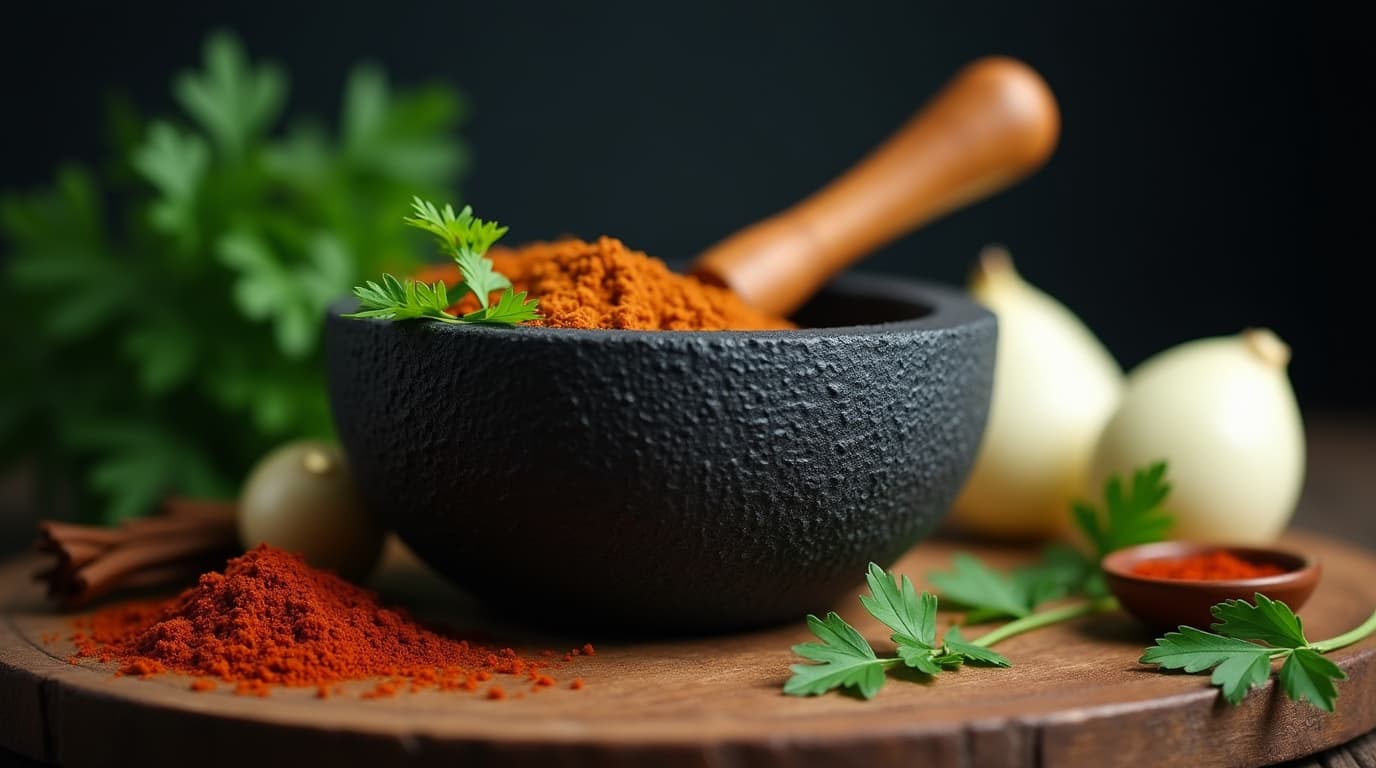A traditional molcajete is a unique kitchen tool with a long history. This article explores the materials used, its cultural importance, and proper care. Learn all about this amazing tool.
What Is A Traditional Molcajete Made Of? The Ancient Tool
The traditional molcajete is more than just a kitchen tool. It’s a piece of history that connects us to ancient culinary practices. Typically, these tools are made from volcanic rock. This specific type of rock provides the ideal surface for grinding. The volcanic material is therefore very strong and slightly porous. This makes it perfect for releasing flavors. Furthermore, the texture allows for efficient crushing of spices and herbs. Additionally, the traditional molcajete’s construction is key to its function.
The Volcanic Rock Foundation of the Molcajete
The primary material used in a traditional molcajete is volcanic rock. This specific type of rock comes from areas with volcanic activity. Accordingly, the selection of material is not random. This rock is chosen for several reasons. First, its strength ensures the molcajete can withstand the pounding and grinding of food. Second, its porous texture helps in the blending of flavors. Third, its dense nature gives it a substantial weight, making it stable. Moreover, this rock is also quite durable. The texture allows for effective grinding of ingredients. The traditional molcajete’s foundation is a key aspect of its enduring appeal.
The Traditional Hand-Carved Construction
Traditionally, molcajetes are hand-carved. Artisans use tools to shape the volcanic rock into the iconic bowl and pestle. This process is both time-consuming and skilled. However, the result is a unique piece of cookware with slight variations. Therefore, each molcajete is a work of art. Indeed, the skill involved in crafting these tools has been passed down through generations. Furthermore, the hand-carved design adds to its charm. No two molcajetes are exactly alike. This construction further enhances their value. The careful carving is a testament to the traditional methods.
Why Volcanic Rock is Ideal for a Traditional Molcajete
Volcanic rock isn’t just any stone; it’s ideal for traditional molcajetes. Specifically, it’s the unique properties of this rock that make it perfect. For example, its porous surface is key to releasing the full flavor of spices. This natural texture allows for thorough grinding and blending. Another benefit is the rock’s durability, which withstands constant use. The slight roughness aids in the process. Basically, volcanic rock provides the ideal combination of strength and texture. This makes it a traditional choice for this culinary tool.
Porous Texture: Flavor Enhancement
One of the main reasons volcanic rock is favored for molcajetes is its porous texture. This unique feature allows the spices to be ground more effectively. Additionally, this texture traps small particles of the food. These particles help to create a paste-like consistency. Conversely, a smooth bowl would cause ingredients to slide around. The porous texture allows the ingredients to be easily ground and mixed. Consequently, the flavors of the ground ingredients are enhanced. The traditional molcajete’s texture is an advantage to every cook.
Durable Material: Long-lasting Use
Another significant advantage of volcanic rock is its durable material. This stone can withstand constant grinding and pounding without breaking. Because the molcajete is meant for continuous use, durability is vital. Therefore, volcanic rock provides the necessary toughness for a long-lasting tool. Especially when preparing recipes that require some effort, having a durable tool is essential. Accordingly, the strength of the stone ensures the traditional molcajete will last for years. Furthermore, this durability makes the molcajete a good investment for any kitchen.
The Tejolote: Partner to the Molcajete

Another essential part of the traditional molcajete is the tejolote, or pestle. This tool is used to grind ingredients within the molcajete. Just like the molcajete, the tejolote is usually made from the same volcanic rock. This ensures a consistent texture for grinding. Similarly, the weight of the tejolote helps to crush the food. The tejolote and molcajete work together seamlessly. Moreover, its ergonomic design makes it comfortable to use. The traditional design ensures the tejolote fits snugly within the molcajete, aiding in grinding.
Material Consistency: Tejolote and Molcajete
Usually, both the tejolote and molcajete are made from the same material. Specifically, this is volcanic rock. This matching material offers several benefits. First, the similar texture provides consistent grinding. Second, the tejolote and molcajete are designed to work as one. Hence, their material consistency is crucial. Third, the similar material helps to ensure both tools wear at the same rate. Ultimately, the traditional molcajete and tejolote work better together when made from the same material.
The Traditional Tejolote Design
The traditional tejolote has a specific design. Typically, it’s a short, stout cylinder with a wide base and a rounded tip. Initially, this shape allows for a comfortable grip. Specifically, the wide base is effective for grinding. Afterward, the rounded end helps in crushing and mixing ingredients. In addition, the tejolote is sized appropriately to fit within the molcajete. Because of this careful design, the tejolote is very effective. This thoughtful design supports the overall function of the molcajete.
Cultural Significance of the Traditional Molcajete
The traditional molcajete is deeply rooted in cultural history. Furthermore, it represents a bridge to ancient cooking techniques. Indeed, it’s more than just a cooking tool. Equally, it’s a symbol of family traditions and cultural heritage. The molcajete is still used in many homes for preparing classic dishes. Moreover, it holds a special place in the heart of traditional cooking. This tool brings generations together. The cultural significance of this kitchen tool cannot be overstated.
Ancient Roots and Traditional Methods
The traditional molcajete has ancient roots. Specifically, it has been used for centuries in Mexican and other Latin American cultures. Initially, it was used by indigenous people for grinding grains, herbs, and spices. Subsequently, its use evolved to making salsas, guacamole, and other dishes. Therefore, the molcajete is a link to historical cooking techniques. Explicitly, its traditional methods have been passed down through families. Likewise, it represents a valuable part of culinary heritage.
Symbolism in Family and Community
Furthermore, the molcajete holds significant symbolism in families and communities. Particularly, it’s often passed down through generations as a family heirloom. Consequently, this adds a sentimental value to the tool. Generally, meals prepared with the molcajete are associated with family gatherings and celebrations. The traditional molcajete symbolizes love and togetherness. Ultimately, it represents the connection between generations. The molcajete’s role in community is significant.
Preparing a Traditional Molcajete for First Use

Preparing a new traditional molcajete properly is very important. Because it’s made of volcanic rock, it needs to be “seasoned” before use. This process helps to smooth out the rough surface of the stone. Moreover, seasoning gets rid of any loose particles that could end up in the food. The traditional method involves grinding raw rice to create a fine paste. This also helps to enhance the flavor of your molcajete over time. Basically, proper preparation ensures a longer life for the tool.
The Importance of Seasoning
Seasoning a traditional molcajete is crucial before the first use. Especially, the rough texture of the volcanic rock can cause problems initially. By seasoning, you remove small rock particles. Moreover, seasoning smooths the surface of the stone. Further, this process allows the flavors of the spices to develop fully. Therefore, taking the time to season a new molcajete is well worth it. This traditional step will improve the flavor of dishes made with it.
Step-by-Step Seasoning Guide
First, start by rinsing the molcajete with warm water. Then, let it air dry completely. Next, put about a cup of raw white rice in the molcajete. Afterward, begin grinding the rice with the tejolote. Continue until the rice turns into a fine powder. Repeat this process with more rice if needed, until the rice powder is white. Finally, rinse the molcajete and let it dry. This simple method will help to prepare the molcajete for use. This step-by-step process makes seasoning very easy.
Maintaining Your Traditional Molcajete
Maintaining your traditional molcajete is essential for its longevity. However, the care is simple. Initially, avoid using soap. The porous nature of the stone will absorb the soap flavor. Instead, rinse with warm water and use a brush. Additionally, make sure to dry the molcajete completely after cleaning. Thus, these simple steps will keep your tool in good condition. Proper care ensures your molcajete will be a lasting culinary companion.
Avoid Soap: Preserve Flavor
Chiefly, it’s important to avoid using soap when cleaning your traditional molcajete. Generally, the porous material can absorb the soap. Consequently, this will affect the flavor of your food. Instead, simply rinse the molcajete with warm water. Moreover, use a brush to remove any food particles. Therefore, maintaining your molcajete without soap is key to its flavor. Basically, this simple rule helps to maintain the traditional character of the tool.
Proper Drying Technique
Another important aspect of caring for your molcajete is proper drying. Specifically, after rinsing, make sure to dry it completely. Additionally, allow the molcajete to air dry for a while. Because moisture can encourage the growth of mold or mildew, this is necessary. Furthermore, using a clean cloth will help to absorb any water. Thus, proper drying helps keep your molcajete in great condition. Undoubtedly, this simple step will help extend the lifespan of your molcajete.
Cooking with a Traditional Molcajete
Cooking with a traditional molcajete is a unique experience. Generally, it enhances the flavors of dishes in a way that other tools can’t. Because of its texture, the tool helps to blend flavors deeply. For example, when making salsa or guacamole, the molcajete creates a richer taste. Moreover, the process is a great experience that connects you to traditional cooking. Therefore, the molcajete is more than just a tool. Indeed, it’s an essential element for authentic dishes.
Flavorful Salsas: A Molcajete Specialty
Specifically, molcajetes are famous for making flavorful salsas. Initially, the rough texture of the stone helps to release the natural oils of spices and vegetables. Also, the manual grinding enhances the texture of the salsa, giving it a unique feel. Therefore, a molcajete brings a different level of flavor. Because the process is gentle, you avoid overworking the ingredients. Moreover, the taste of a molcajete salsa is unlike any other.
Grinding Herbs and Spices: The Authentic Way
Grinding herbs and spices in a traditional molcajete provides an authentic culinary experience. Initially, it releases the oils and aromas of the ingredients more effectively. Moreover, the molcajete’s texture helps in creating a fine powder. Therefore, Specifically, this makes a difference in the final outcome of a dish. The traditional method brings out rich and complex flavors. Undoubtedly, it elevates the quality of the meal.
Conclusion: The Enduring Legacy of the Traditional Molcajete
In conclusion, the traditional molcajete is more than just a kitchen tool. It’s an artifact with deep cultural roots and a unique ability to enhance flavors. Specifically, its construction from volcanic rock is crucial to its function. Moreover, proper care and use ensure it remains a valuable part of any kitchen. Therefore, it is a testament to the timeless nature of simple and effective design. The traditional molcajete is both a practical tool and a cultural treasure.
Frequently Asked Questions (FAQs)
Q: What is a traditional molcajete?
A: A traditional molcajete is a mortar and pestle made from volcanic rock. It’s used for grinding and mixing ingredients. It is especially popular in Mexican cooking.
Q: Why is volcanic rock used for molcajetes?
A: Volcanic rock is ideal because of its porous texture. This helps in the efficient grinding of spices. The rock also has the strength to withstand constant pounding. Additionally, its texture helps to release flavor from spices.
Q: What is the tejolote?
A: The tejolote is the pestle that comes with a molcajete. It’s made of the same volcanic rock. It is used to grind ingredients in the molcajete. It fits the bowl.

